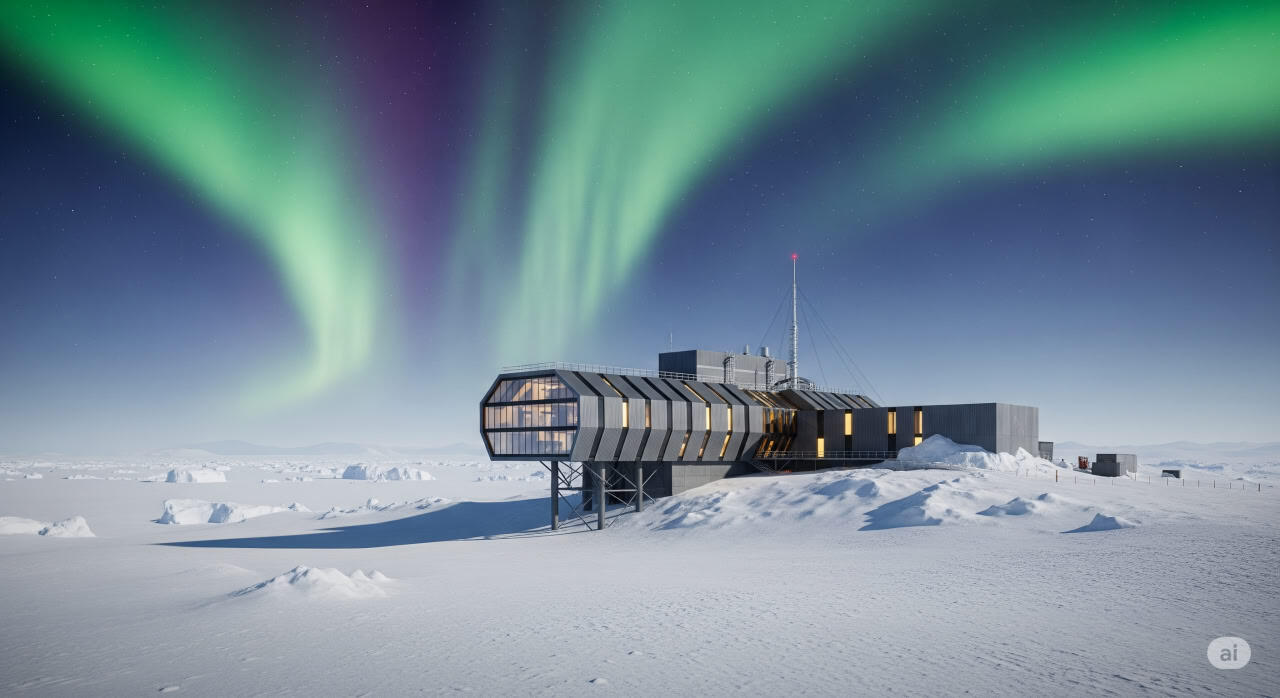Extreme Builds in Antarctica: How Nations Engineer Survival in the Frozen Frontier

How Nations Are Engineering Outposts in the World’s Harshest Environment to Unlock Secrets of Science, Climate, and Survival
Imagine a place where the wind howls like a freight train, temperatures plunge to levels that could freeze your breath mid-air, and the ground beneath you isn’t solid rock but shifting ice that could swallow a building whole. That’s Antarctica—not just a frozen wasteland, but a living, breathing challenge to human ambition. Yet, scattered across this icy continent are outposts of ingenuity, bases built by nations around the world to push the boundaries of science while staring down nature’s fury. These aren’t mere shelters; they’re feats of engineering that blend cutting-edge tech with old-school grit, all in pursuit of understanding our planet’s past, present, and precarious future.
I’ve always been fascinated by these remote stations. They’re like tiny bubbles of civilization in a sea of white, where researchers endure months of isolation for the sake of discovery. But why go to such extremes? Antarctica holds clues to climate change, cosmic mysteries, and even potential resources hidden under the ice. And let’s not forget the geopolitics—countries staking their claim in a land governed by a fragile treaty that bans military activity and mining, for now. As global warming accelerates, melting ice shelves and opening new shipping routes, these bases could become flashpoints in international relations. In this deep dive, we’ll explore some of the most remarkable ones, from sleek modern marvels to time-tested survivors, unpacking their designs, histories, and the bigger picture they paint about humanity’s place on Earth.
South Korea’s Jang Bogo: A Stealthy Sentinel on the Ross Sea
Picture this: a structure that looks more like a futuristic spaceship than a research lab, hunkered down on the edge of the Ross Sea. That’s Jang Bogo Station, South Korea’s proud entry into Antarctic exploration, opened in 2014 as their second base on the continent. It’s a testament to how national pride and scientific curiosity can converge in the most unforgiving spots.
South Korea’s Antarctic journey started modestly in the late 1980s with King Sejong Station, but Jang Bogo marked a bold step up. Named after a legendary Korean admiral, it symbolizes the country’s growing role in global science. Geopolitically, it’s no accident—Antarctica is a stage for soft power, where nations like South Korea, emerging from decades of rapid industrialization, showcase their tech prowess. With climate data becoming crucial for everything from agriculture to disaster planning back home, bases like this give Seoul a front-row seat to planetary changes.
What makes Jang Bogo stand out is its design, honed for survival. Engineers drew inspiration from aerodynamics, testing models in wind tunnels to craft a low-profile shape that slices through gales exceeding 300 kilometers per hour. The exterior panels are dimpled, much like a golf ball, to reduce drag and prevent snow buildup— a clever trick that keeps the station from turning into an igloo. Raised on foundations, it allows blizzards to sweep underneath, avoiding buried entrances that could trap people inside.
Spanning about 4,600 square meters across 16 interconnected buildings in a Y-shaped layout, it’s divided smartly: one arm for labs, another for living quarters, and the third for operations. This isn’t just efficient; it’s a safety net. Firewalls separate sections, and multiple exits ensure quick escapes in emergencies. Insulation is top-notch—five-layered windows trap heat when temps dip below -30°C, and the whole setup is angled to block winds while soaking up summer sun.
Building it was an epic logistics puzzle. Modules prefabricated in Busan were shipped to New Zealand, then ferried across treacherous seas by icebreaker. In summer, it buzzes with up to 62 researchers; winter pares it down to 23 hardy souls. Life here is regimented—data limits curb smartphone addictions, and a small hydroponic garden provides fresh greens, a psychological boost during endless nights. Isn’t it wild how a few lettuce leaves can combat cabin fever in such isolation?
Reflecting on Jang Bogo, I can’t help but admire how it embodies resilience. In a world where climate threats loom large, stations like this aren’t just about data—they’re about proving we can adapt. But it also raises questions: as more nations pile in, will the Antarctic Treaty hold, or will competition turn icy?
Belgium’s Princess Elizabeth: Pioneering Zero-Emission Polar Living
Shifting east to the Utsteinen Ridge, we find Belgium’s Princess Elizabeth Station, a beacon of sustainability amid the white expanse. Opened in 2009 after two grueling summer builds, it’s hailed as the world’s first zero-emission research base, running solely on wind and solar. In an era where environmental hypocrisy runs rampant, this feels like a genuine win—proof that even in extremes, we can tread lightly.
Belgium’s Antarctic history traces back to the heroic age of exploration. Adrien de Gerlache led the first overwintering expedition in 1897-1899, enduring scurvy and madness aboard the Belgica. That spirit of endurance lives on, but now it’s channeled into green innovation. Geopolitically, for a small nation like Belgium, this base asserts influence in international forums, contributing to global climate talks with hard-won data.
Construction was a nightmare on granite bedrock that chewed through drill bits, but once anchored, the station came together from 100 containers shipped from Antwerp. Its compact, aerodynamic form withstands 300 km/h winds, wrapped in a nine-layer wall system—aluminum, wood, insulation, even kraft paper—for airtight efficiency.
Power is the star: nine wind turbines churn out up to 54 kW, 284 solar panels generate 420 kWh daily, and thermal panels heat water. Batteries store excess, with hydrogen fuel cells on the horizon. A smart microgrid balances it all, ensuring stability. It hosts up to 50 in summer, with labs, dorms, and communal areas designed for minimal impact—wastewater recycled, trash flown out.
In 2021, it even welcomed Venturi Antarctica, the first electric polar vehicle, underscoring Belgium’s eco-commitment. But here’s a thought: as ice melts and tourism rises, can such purity last? Princess Elizabeth inspires, reminding us that innovation can harmonize with nature, yet it highlights our broader failure to apply these lessons globally.
India’s Bharati: Modular Mastery from Shipping Containers
Now, let’s talk about ingenuity on a budget—India’s Bharati Station, perched in the Larsemann Hills by Prydz Bay. Built entirely from 134 modified shipping containers in just 127 days back in 2012, it’s a modular marvel that floats above the ice on stilts, defying blizzards and proving that smart design trumps brute force.
India’s Antarctic saga began in the 1980s with Dakshin Gangotri, now a supply hub, followed by Maitri. Bharati, their third, reflects a rising power’s ambitions. As the world’s most populous nation grapples with climate impacts like monsoons and heatwaves, Antarctic research informs everything from weather models to space tech—ISRO uses it for satellite data relay. Geopolitically, it’s a subtle claim in a continent eyed for minerals, positioning India among the elite nine with multiple bases inside the Antarctic Circle, alongside heavyweights like the US and Russia.
Prefabricated in Germany and shipped via Antwerp and Cape Town, its aerodynamic shape—tested in wind tunnels—braves 322 km/h gusts, anchored by Y-shaped columns and a concrete core. Ground floor: labs and storage; second: living with gym, library, and OR; top: air systems and terrace.
Power from kerosene CHP units recycles heat—no central system needed. Designed for 25 years and full dismantlement per treaty rules, it’s eco-conscious. What strikes me is the efficiency—proving developing nations can lead in polar science without massive budgets. Yet, with Antarctica’s resources tempting, will environmental vows hold when push comes to shove?
Brazil’s Comandante Ferraz: Rising from the Ashes
Tragedy often breeds triumph, and Brazil’s Comandante Ferraz Station is a prime example. After a 2012 fire razed the original, Brazil invested $100 million to rebuild bigger and better, reopening in 2020. It’s a story of resilience, mirroring the nation’s own ups and downs.
Brazil joined the Antarctic club in 1984, drawn by marine biology and climate links to the Amazon. The fire was a setback, but the comeback underscores commitment. Geopolitically, as a BRICS member, Brazil uses this to amplify its voice on global issues, from biodiversity to sea-level rise threatening Rio’s coastlines.
Designed by Studio 41 with Chinese firm CEIEC, the 4,500-square-meter setup features two elevated linear buildings on stilts, easing snow management and assembly. Seventeen labs tackle microbiology to climate, with DNA sequencers and purifiers. Amenities like a gym and library combat isolation.
Solar and wind supplement power, sited between lakes for resource access. It’s sustainable, but the rebuild prompts reflection: fires highlight risks in remote spots. As Brazil pushes south, it reminds us that exploration demands respect for the environment—and each other.
Germany’s Neumayer III: The Station That Lifts Itself
Germany’s Neumayer III is like a sci-fi elevator on ice— a 2,300-ton behemoth on 16 hydraulic legs that rise annually to outpace snow accumulation. Opened in 2009, it’s the third iteration, evolving from predecessors buried by drifts.
Germany’s polar roots run deep, from early 20th-century expeditions to post-WWII redemption through science. Neumayer III, costing €39 million, advances meteorology and geophysics. Geopolitically, it’s Europe’s anchor, feeding data to EU climate policies amid Arctic rivalries spilling south.
The four-story steel giant, 68 meters long, was wind-tunnel tested for aerodynamics. On a floating shelf moving 160 meters yearly seaward, it’s diesel-powered with wind assist, fully dismantlable. Labs, kitchens, even a snow garage inside.
The lifting tech fascinates—software syncs legs, imperceptible to occupants. Planned for 25-30 years, it’s a blueprint for adaptability. But as ice shelves crack from warming, what if it drifts too far? It’s a stark reminder of climate urgency.
Japan’s Syowa: A Timeless Outpost of Endurance
Stepping back in time, Japan’s Syowa Station has hummed since 1957, one of Antarctica’s oldest continuous operations. On East Ongul Island, it’s milder by polar standards, a self-contained village of 70 buildings over 7,000 square meters.
Post-WWII, Syowa symbolized Japan’s scientific rebirth, joining the International Geophysical Year. Today, it monitors CO2, cosmic rays, and magnetism. Geopolitically, for resource-hungry Japan, it’s a foothold in potential future claims.
Raised on concrete to dodge snow, rebuilt in 1993 with fireproof timber, it’s maintained meticulously—some 1960s structures still stand. Knowledge handoffs ensure continuity.
It’s inspiring how tradition meets tech, but isolation’s toll weighs heavy. How do people cope with year-long rotations? Syowa teaches persistence, yet underscores mental health needs in extremes.
Poland’s Henryk Arctowski: A Golden Rebirth on the Horizon
Finally, Poland’s Henryk Arctowski on King George Island is getting a facelift—rebuilt from scratch for completion around 2027. Costing $40 million, it’s prefabricated in Poland, shipped in 113 containers.
Named after a Belgica expedition member, it nods to Poland’s exploratory heritage since 1977. Geopolitically, amid European tensions, it’s a scientific outpost bolstering alliances.
On 3-meter stilts, airplane-wing shaped for winds, clad in golden alloy. Inside: wood finishes, shutdown zones for efficiency, greenhouse, glacier water reservoir, wind power. Big windows for views, housing 70 in summer.
It’s forward-thinking, but funding hikes in 2024 hint at priorities. As Poland invests, it sparks hope for collaborative science over competition.
Wrapping Up: Lessons from the Ice
These bases—from Jang Bogo’s stealth to Arctowski’s glow—illustrate human tenacity. Born from historical quests like Shackleton’s ordeals and the 1959 Antarctic Treaty promoting peace, they now navigate geopolitics in a warming world. Resources beneath the ice tempt, but for now, science reigns.
Yet, concerns linger: environmental footprints, mental strains, rising costs. Are we preserving or intruding? These outposts inspire, urging us to apply their lessons globally. Which would you brave? The ice holds answers—if we listen.



